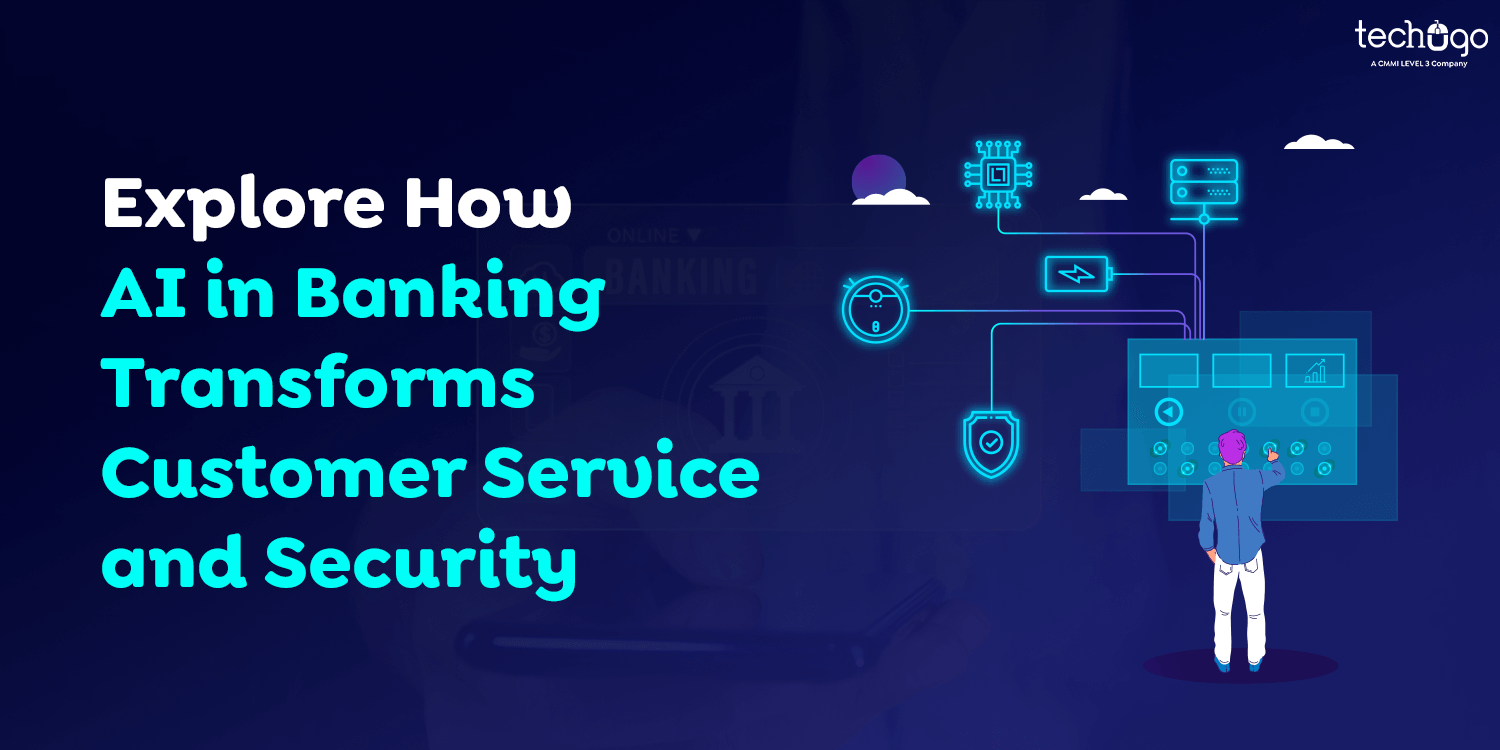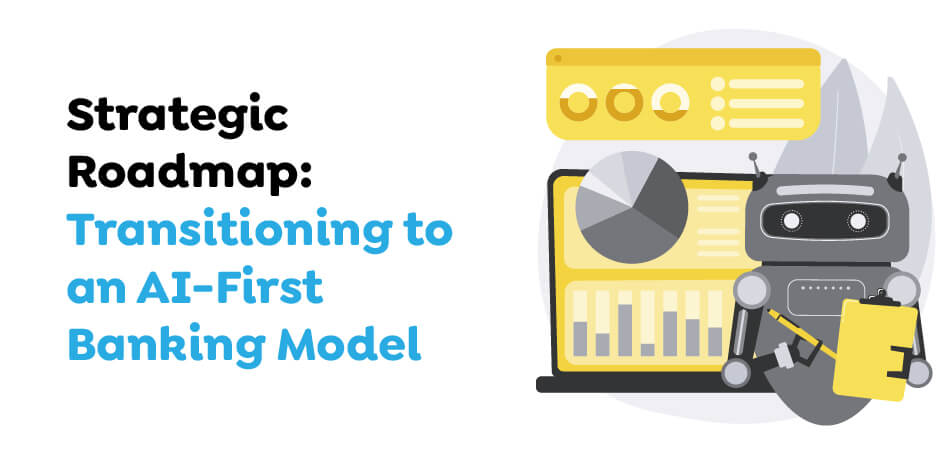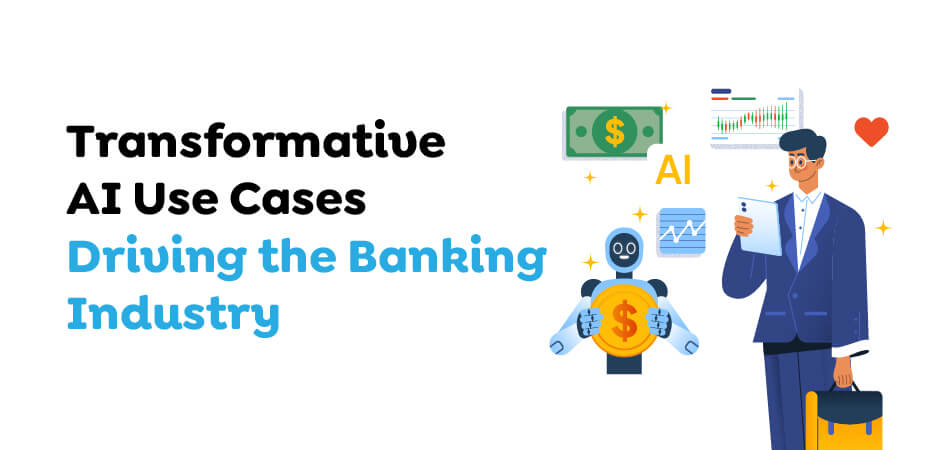31 Jul 2024
Explore How AI in Banking Transforms Customer Service and Security
Matthew Connor

Artificial Intelligence, commonly called AI, is an explosive catalyst driving transformational change across different industries. One area that is witnessing a significant change in AI is banking. This article will look at the various ways that AI alters finance’s nature. We will decode the intricate complexities of AI-powered banking by explaining complicated concepts in a simple and easy-to-understand way.
Recent data from a Business Insider report reveal that around 88% of banks know the immense benefits of AI in banking industry. Additionally, a different report produced by McKinsey highlights the massive potential for growth AI can get to the financial and banking sectors. It estimates its value to be as high as $1 trillion.
These findings highlight the growing recognition within the business community of AI’s revolutionary capabilities and its potential to transform banking operations and the financial services sector.
Applications of AI in Banking and Finance

Artificial intelligence has become essential to our lives, and banks have incorporated this technology into their services and products. Here are some of the most significant AI app within the banking sector:
Cybersecurity and Fraud Detection
Many digital transactions happen every day as customers pay their bills, withdraw cash, and deposit checks. They also do many other things using websites or apps. Therefore, there is a rising demand for banks to increase their efforts to detect fraud.
This is where AI in Banking comes into play. AI and machine learning help banks spot fraudulent activity, identify loopholes within their systems, limit risks, and enhance the security of online transactions.
One example of a financial institution using AI for fraud detection is Danske Bank, the largest Danish bank with a fraud detection system within its business. The deep-learning tool improved the bank’s fraud detection capability by 50% and decreased false positives by 60%. The fraud detection system based on AI has also been able to automate various important decisions and refer certain instances to human experts for further analysis.
AI can also assist banks in managing cyber threats. In 2019, the financial sector represented 29 percent of all cyberattacks, making it the most targeted sector. With artificial intelligence’s constant monitoring of intelligence in the financial industry, banks can respond to cyber attacks before they harm customers, employees, or their internal systems.
Chatbots
Chatbots are among the finest examples of real-world applications of AI in the banking industry. Once deployed, they operate all hours of the day, unlike humans, who have set working hours.
They also continue to gain knowledge about use patterns, which helps them comprehend users’ needs effectively.
Banks can integrate chatbots into banking applications to ensure they are accessible to their customers 24/7. Furthermore, by learning about customers’ behavior, chatbots can provide personalized customer service, reduce the burden of emailing and other channels, and suggest appropriate financial products and services.
One of the finest instances of AI chatbots in banking applications is Erica, a virtual assistant at Bank of America. The AI chatbot efficiently and effectively manages credit card debt reduction and security updates for cards, which allowed Erica to handle more than 50 million requests from clients in 2019.
Loan and Credit Decisions
Banks are using AI-based systems to make better-informed, more secure, profitable, and safer decisions about credit and loans. Today, many banks remain limited in their ability to rely on credit scores, credit histories, and customer references to judge a person or a company’s creditworthiness.
Indeed, The credit report system is frequently filled with mistakes, missing historical transaction data, or inaccurately classifying creditors.
A credit and loan system will analyze the patterns and behavior of those with a limited credit history to assess their creditworthiness. Additionally, the system warns banks about specific behavior that can increase the likelihood of a default. In short, these technologies play an essential role in shaping the way that consumer lending is conducted.
Tracking Market Trends
AI-ML, used in financial services with the help of a mobile app development company in Canada, enables banks to process huge amounts of data and forecast current market trends. Advanced machine learning algorithms help analyze market trends and recommend investing options.
AI solutions for banking can also recommend the most appropriate time to buy stocks and warn investors of a possible risk. Because of its large processing capabilities, this new technology aids in decision-making speed and facilitates trading for banks and their clients.
Data Collection and Analysis
Banks and financial institutions track millions of transactions every day. Because the amount of data generated is massive, collecting and registering it can be overwhelming for employees. Organizing and recording massive amounts of data without error is impossible.
Innovative AI and machine learning app development company can help in the efficient collection of data and analysis of these situations. This helps improve users’ overall experience. This information could also be used to detect fraud or make credit decisions.
Customer Experience
Customers are constantly seeking more convenience and a better experience. For instance, ATMs were a success because customers could take advantage of the essential benefits of making deposits and withdrawing cash even when not working at banks.
This kind of convenience has only prompted further innovation. Customers can now access bank accounts from their homes with their mobile phones.
Combining artificial intelligence (AI) in financial services and banking improves the user experience and enhances customers’ convenience. AI technology can reduce the time required to collect Know Your Customer (KYC) data and eliminate mistakes. In addition, new financial products and deals are made available in time.
The eligibility requirements for situations like seeking credit or a personal loan can be automated by AI. This means that clients can avoid the stress of having to manually go through the entire procedure. Additionally, AI-based software speeds up the approval process for loans and disbursements.
Artificial Intelligence the banking client support assists in accurately capturing customer information to create accounts without error and ensure a seamless customer experience.
Risk Management
External global influences like natural disasters, currency fluctuations, and political instability can significantly influence the banking and financial industries. When times are volatile, making business decisions prudently is vital. Generative AI in banking offers analytics that provide a precise picture of what’s coming and allow you to be prepared and make quick decisions.
AI for banking can also help identify risky applications by evaluating the possibility of a user defaulting on the loan. It anticipates future behavior by analyzing previous behavioral patterns and data from smartphones. Check out the blog to learn how technology is shaping the future of lending via digital technology.
Regulatory Compliance
Banking is among the areas that are highly controlled in the world economy. The government uses its power of regulation to ensure that customers of banks aren’t using banks to commit financial crimes and that banks operate with acceptable risk-response profiles to avoid massive-scale defaults.
The majority of banks have an internal compliance group to handle these issues; however, these processes take much longer and require massive investments when handled by hand. Compliance regulations are frequently subject to change, and banks have to modify their processes and workflows constantly in accordance with these rules.
AI and ML in banking employ advanced learning techniques and NLP to understand new compliance requirements for banks and enhance their decision-making processes. While AI within the banking industry cannot replace compliance analysts, it can help improve their efficiency and speed.
Predictive Analytics
The most popular uses of AI in the banking sector are general-purpose semantic and natural language applications, as well as widely used predictive analytics. AI can identify certain patterns and relationships within the data that traditional technologies could not detect.
These patterns indicate an unexplored sales opportunity, such as cross-selling or operational data metrics, which can directly impact revenue.
Process Automation
Automated process automation (RPA) algorithms improve operational efficiency and cut expenses by automating time-consuming repetitive tasks. They also let users concentrate on more complicated tasks that require human involvement.
As of now, banking institutions have successfully used RPA to improve transaction speed and efficiency. For instance, JPMorgan Chase’s CoiN technology examines documents and extracts data from them faster than a human. Check out the linked blog to find out how RPA has transformed the insurance industry.
Also Read : How to Develop an AI App: From Concept to Launch
Transformation into an AI-First Bank: The Strategic Roadmap

If banks want to become leaders in adopting AI in finance and banking, moving to an AI-first strategy is vital. This requires the integration of AI technologies into a fundamental aspect of the bank’s processes and interactions with customers. Here are the steps that can assist a bank in becoming AI-first
Assess the Current State and Future Potential of AI
A bank should thoroughly assess its current capabilities when using AI bank solutions. This requires understanding the present problems and identifying potential opportunities to make the most of AI implementation. Comparing yourself to competitors can provide insights into the bank’s overall situation when implementing AI for banking. In addition, identifying trends and instances of AI in banking can help assess the impact AI has on cost, revenue, and overall efficiency.
Define the AI Vision and Ambition
The next stage is to create an unambiguous AI vision that is aligned with the bank’s overall business plan. The vision should outline the ways in which AI will increase value for employees, customers, and others. Determining how to define the AI worth proposition and how it differs from other banks in the market is vital to establishing a clear strategy and setting goals.
Develop an AI Roadmap and Governance
An AI plan of action outlines the exact actions and priorities to implement the Bank’s AI vision. Affixing specific roles and responsibilities to each AI initiative guarantees accountability and tracks progress. Also important is establishing solid governance for AI that addresses security, data quality ethics, privacy, and risk management. This framework for governance is essential to ensure sustainable and responsible AI deployment.
Build AI Capabilities and Culture
The bank must invest in vital AI technology, infrastructure, and equipment to support its AI initiatives. It is equally important to attract and develop talent skilled in AI and machine learning. Creating the right environment for AI experimentation and creativity encourages the ability to collaborate and solve problems. Instilling a culture that is constantly learning, trusting, and empowering is crucial to the achievement of AI projects.
Monitor and Measure AI Performance and Impact
It is also crucial to review and assess the results of AI initiatives. The results of AI projects should be evaluated against established guidelines for governance, and a roadmap aids in assessing the effectiveness of AI initiatives. Gathering the feedback of AI groups and their users can be essential to improving and refining AI products and solutions, making sure that they meet the ever-changing demands of the bank as well as its customers.
Following these guidelines, banks will be able to effectively transition to becoming AI-first and leverage the revolutionary capabilities of AI to rethink their business processes and customer experience. This method of implementing AI helps banks profit from the immense opportunities offered by AI and ML, thereby separating them from the competition in finance and banking.
Also Read : How AI is going to transform Fintech in Canada
Embracing the Future: The Role of AI in Reshaping the Banking Sector

The adoption of artificial intelligence in banking is a significant shift in the financial market. Using AI technology isn’t an unintended trend but a need for banks to stay current and competitive. AI in banking presents unbeatable possibilities for efficiency, innovation, and personalization, completely changing how banks interact with clients.
Introducing AI within banking institutions is multifaceted and requires a thorough analysis of the current abilities, an enlightened and precise plan of AI integration, and a plan of action for implementation. The process also requires robust governance and a strong spirit of innovation and adaptability.
Banks must navigate the new issues and opportunities offered by AI and machine learning. The most important factor to succeed is finding a balance between technological advances and human insights. While AI can streamline processes and improve data analysis, human interaction is essential in fields that require compassion, judgment, and personal interaction.
The future of banking is interwoven with AI. Banks that embrace AI and incorporate it successfully in their daily operations are well placed to take the lead in a new age of banking, characterized by improved customer experience, operational excellence, and new solutions for financial services. As we advance technologically artificial intelligence, the banking industry will continue to develop and open the way to the most advanced, efficient, and customer-centric banking methods.
Also Read : How AI is helping the entire healthcare industry
Popular Use Cases of AI in Banking

Finance and banking are among AI technology’s top and early adopters due to its operational advantages. In addition to digital banks, automated AI-powered banks have investigated a myriad of uses or, you know, applications. Some examples of the most well-known uses of AI in banking are:
AI-powered RPA for Improved Operational Cost and Risk Management
We all love interacting with other humans when it comes to requesting bank information or aid in operations, but to achieve this, we must modify our processes. This could be a result of time constraints specifically.
Furthermore, banks have also digitized their processes to provide convenience to employees and customers alike. In the banking industry, human-powered processes that require paperwork are always required. The tiniest error could result in significant financial costs and risk concerns.
AI is renowned for its efficiency in automating processes, personalizing services, and managing many processes at a rapid pace. It is constantly evolving with the emergence of new data streams, and the benefits of AI in terms of reducing costs are significant.
An AI usage case dubbed RPA software intelligently follows and automatizes digital processes based on certain rules is a part of it. In conjunction with natural language processing, recognition of handwriting and text, and various other sophisticated AI abilities, RPA bots can offer an array of smart processes that were not time-sensitive or vulnerable to errors prior.
A few AI-powered RPA applications in banking are:
- Customer onboarding involves collecting and verifying customer data, conducting background checks, and completing necessary forms and documents.
- Account Maintenance includes changing customer information, completing account closures, and coordinating changes to the status of your account (e.g., freezing accounts or activating dormant accounts).
- Credit assessment and underwriting. Helped analyze data from applicants, obtain credit scores, assess the risk of a loan, streamline approval procedures, and create credit reports.
- AI-powered fraud detection in banking operations. It monitors real-time transactions by identifying suspicious patterns and irregularities and triggering alerts to conduct further investigations.
Additionally, JPMorgan has been using AI-powered large language models (LLMs) to speed up the payment process, providing quicker processing times and reducing false positives. This has helped decrease the rejection of accounts rate by around 15 percent. Additionally, it uses AI to provide customers with better analysis of their finances, including exact cash flow analysis upon request.
Generative AI-powered Chatbots for Special Attention to Customer Service
A robust customer service system can help improve acquisition and retain existing customers. Not only other companies but also banks must do this. However, before the digital revolution at banks, customers needed to make many changes to their banking.
A few years back, this transformation was limited to paying bills, transferring money, requesting checkbooks, quick access to bank statements/passbooks, and more. However, for more advanced support, customers must go to the bank, write, or contact the customer support center. This can be a hassle for many!
This is the place where Generative AI comes in! Generative AI can contribute to the banking sector if you’re checking bank segmentation and other functions. It’s like the below chart of the composition of conventional AI and analytics Advanced AI, and Generative AI:
Generative AI in banking provides information and responds to certain types of requests in the same way bank personnel do.
Bank of America uses AI to handle customer queries. BNY Mellon, a global investment bank, utilizes chatbots powered by AI to streamline requests for funds transfers, which has helped it save about $300,000 a year and provide efficient customer support.
If we examine the possibilities for Generative AI in banking each year, it generates significant worth for banks. It ranges from $200-340 billion, representing about 9-15% of the total. The only requirement to achieve this is the most effective level of execution.
AI to Improve Compliance with Regulations and Standards with proactive fraud detection
Looking worldwide, you’ll discover banking is a highly regulated industry. It’s a must, considering that it is the largest storage facility for the sensitive financial information of its users, and the slightest mistake can cost users a lot of money.
Regulations ensure that bank employees treat clients with respect and transparency. They create rules on concerns such as fair lending practices, disclosure of fees, and safeguarding of consumer data to protect customers’ rights.
They usually require the strictest money laundering (AML) prevention and know-your-customer (KYC) methods to stop criminal activities such as financing terrorists and fraud.
The question now is: Which banks need to catch up behind and need assistance from AI to address compliance requirements and regulations?
Choosing a particular banking regulatory compliance monitoring is costly and a risk that some banks might need help to justify investing. To reduce costs, a majority prefer to integrate or implement AI virtual assistants to maintain a close eye on the accumulating transactions and customer behaviors, conduct audits, produce reports on compliance with regulations, and minimize the risk of fraud.
When we speak about regulatory and compliance reporting for the BFSI section, that means automated compliance-based monitoring, KYC checks, anti-money laundering screening, flagging suspicious activity, and much more.
A well-known bank, HSBC, has benefited from AI for compliance checks using Ayasdi, which helped cut false positives down by 20 percent.
In addition, Barclays, a British Universal Bank, added an AI tool to its system. This tool tracks merchant transactions in real-time to detect possible fraudulent activity and take action to prevent it.
AI for Loan and Credit Decision Making
We are all aware that banks have to deal with a lot of data. They find ways to take on new customers as loans or to approve loans to certain customers that are not risk-free for the institution while ensuring compliance. The manual process of processing all this data can be lengthy and time-consuming and require additional investment.
In addition, approving loans involves checking credit scores, history, and other factors to determine if the applicant is eligible for the loan. This process ensures banks that their credit is safe and can be repaid by negotiating interest rates.
This is why banks can count on AI-powered systems based upon a wide and varied set of data, which help analyze loan eligibility. They also help banks analyze their huge database of customer information to locate potential customers who might be seeking financing to explore business opportunities.
AI-based software for lending underwriting as well as loan acceptance could aid banks in:
- Perform data processing faster than a human can, which speeds up the process of loan approval.
- Examine a borrower’s creditworthiness more precisely and reduce the chance of making a mistake in the decision process.
- Examine the various risk factors associated with a loan application and provide more accurate predictions of default risk.
- Personalized loan recommendations are based on specific customer profiles, considering aspects like financial status, credit history, and spending habits.
- Manage many loan requests simultaneously and allow banks to increase the size of their lending operations with greater efficiency.
- Continuously learn from previous loans and feedback, enhancing their efficiency and accuracy as time passes.
However, when using AI tools to evaluate credit or loan underwriting approval, it is essential to be sure that they have been designed to be impartial, which most of these tools don’t.
AI Advisory and Automated Actions for Better Investment Management
Putting money into work is a favorite topic- financial investors or banks. In the past, banks would invest their market data to work, then analyze these, and identify more lucrative investment opportunities.
Today, as a result of AI development and advancement, companies are investing in the development of AI tools for market investing that can not only offer investing opportunities but can also automate them to a certain extent. This should be according to users’ patterns of investment and their ability to accept risk and budget. Implementing this advanced AI solution into their stock investment software can help them provide an improved experience for investors and clients.
Firms such as UBS, a Swiss-based company UBS, and the Netherlands-based ING have AI technology that continuously analyzes markets to identify investment opportunities and update their algorithms to match their traditional systems to streamline investing processes. This frees customers from the burden of checking the price of stocks and making decisions every minute and allows them to complete their thorough market research to increase their portfolios and create wealth.
Bank of America uses a platform called Glass, which allows investment bankers to discover market opportunities and recommend them to their clients to improve their portfolios.
Additionally, many banks build AI-powered robo-advisors designed to assist their clients with their investment questions and improve their portfolio management. If these AI advisors are powered by dynamic AI with personalization capabilities, then they will be able to provide expert advice on investments according to clients’ investment habits and goals.
JP Morgan has created a tool known as IndexGPT, an AI-powered robotic advisor that acts as the user’s individual financial advisor and has top-quality forecasting and prediction capabilities.
Conclusion
Artificial Intelligence isn’t only a buzzword; it has a revolutionary impact on the world of banking. From enhancing customer service using chatbots to protecting your money against fraud, AI has changed the bank’s operations. As we advance, the synergy between AI and blockchain technologies is set to bring further thrilling advancements.
If you’re looking to check your account balance, seeking advice on investing or even applying for loans, be aware that AI in banking is operating behind the scenes to make banking easier and safer.
Get in touch with Techugo to develop an AI app for the banking sector.
Get In touch
We are excited to here from you and let’s start something special Together. Call Us for any inquiry.
Write us
sales@techugo.caJust a call away
About you




